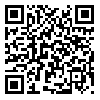Volume 13, Issue 49 (12-2022)
NCMBJ 2022, 13(49): 67-80 |
Back to browse issues page
Download citation:
BibTeX | RIS | EndNote | Medlars | ProCite | Reference Manager | RefWorks
Send citation to:



BibTeX | RIS | EndNote | Medlars | ProCite | Reference Manager | RefWorks
Send citation to:
Kafshnouchi M, Hamedi J. Study of cultivable actinobacterial diversity in Sahoulan Cave and evaluation of their antimicrobial activity. NCMBJ 2022; 13 (49) :67-80
URL: http://ncmbjpiau.ir/article-1-1532-en.html
URL: http://ncmbjpiau.ir/article-1-1532-en.html
Department of Microbiology, Maragheh Branch, Islamic Azad University, Maragheh, Iran
Abstract: (1063 Views)
Aim and Background: Caves are less studied oligotrophic and dark environments and can be suitable sources for finding promising strains having biotechnological potentials. Sahoulan Cave has a dolomitic structure and is located 42 km southeast of Mahabad city. The aim of the current research was to study the actinobacterial diversity of this cave and evaluate their antimicrobial activity.
Materials and Methods: In this project, different samples of soil, water, floor, wall, roof as well as invertebrates of the Sahoulan cave were collected to isolate actinobacteria. To facilitate the isolation, three pretreatments (centrifugation, drying and, microwave) and an antibiotic treatment were performed on the isolates. Then, they were cultured in 10 different isolation media. The isolates were also screened for antimicrobial activity against 10 bacteria and fungi.
Results: From 13 samples obtained from the Sahoulan Cave, 8 actinobacteria were isolated from the genera Streptomyces, Micromonospora, and Lysinibacter. Lysinibacter sp. UTMC 3606 had 99.3% similarity to Lysinibacter cavernae, which was isolated from a cave in China in 2015 as a new species. Of the 8 isolates, 5 isolates had antimicrobial activity, including three Streptomyces and two Micromonospora. Three isolates were active against Staphylococcus aureus and Micrococcus luteus. One isolate was active against Escherichia coli TolC. Antimicrobial activity against Bacillus subtilis UTMC1464 was observed in one strain. Three isolates also showed activity against Candida albicans UTMC5055. The isolated Micromonospora sp. UTMC3322 showed the highest antimicrobial activity against S. aureus, M. luteus, and C. albicans.
Conclusion: Comparison of the obtained results with that of other studies on caves in Iran shows that caves are valuable environments for biodiversity studies and isolation of actinobacteria, however, pristine caves are more preferred. Actinobacterial diversity in the Sahoulan cave was less than Hampoil cave, but the biological activity of the isolates was higher. Study of tourist caves such as the Sahoulan Cave can be a good subject to study the impact of humans and tourism on the biodiversity of caves.
Materials and Methods: In this project, different samples of soil, water, floor, wall, roof as well as invertebrates of the Sahoulan cave were collected to isolate actinobacteria. To facilitate the isolation, three pretreatments (centrifugation, drying and, microwave) and an antibiotic treatment were performed on the isolates. Then, they were cultured in 10 different isolation media. The isolates were also screened for antimicrobial activity against 10 bacteria and fungi.
Results: From 13 samples obtained from the Sahoulan Cave, 8 actinobacteria were isolated from the genera Streptomyces, Micromonospora, and Lysinibacter. Lysinibacter sp. UTMC 3606 had 99.3% similarity to Lysinibacter cavernae, which was isolated from a cave in China in 2015 as a new species. Of the 8 isolates, 5 isolates had antimicrobial activity, including three Streptomyces and two Micromonospora. Three isolates were active against Staphylococcus aureus and Micrococcus luteus. One isolate was active against Escherichia coli TolC. Antimicrobial activity against Bacillus subtilis UTMC1464 was observed in one strain. Three isolates also showed activity against Candida albicans UTMC5055. The isolated Micromonospora sp. UTMC3322 showed the highest antimicrobial activity against S. aureus, M. luteus, and C. albicans.
Conclusion: Comparison of the obtained results with that of other studies on caves in Iran shows that caves are valuable environments for biodiversity studies and isolation of actinobacteria, however, pristine caves are more preferred. Actinobacterial diversity in the Sahoulan cave was less than Hampoil cave, but the biological activity of the isolates was higher. Study of tourist caves such as the Sahoulan Cave can be a good subject to study the impact of humans and tourism on the biodiversity of caves.
Keywords: Actinobacteria, Biodiversity, Sahoulan Cave, Antimicrobial activity, cultivable actinobacteria, Mahabad, Iau Science.
Type of Study: Research Article |
Subject:
Physiology
Received: 2022/01/17 | Accepted: 2022/06/6 | Published: 2023/01/3
Received: 2022/01/17 | Accepted: 2022/06/6 | Published: 2023/01/3
| Rights and permissions | |
 |
This work is licensed under a Creative Commons Attribution-NonCommercial 4.0 International License. |





